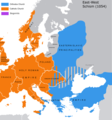Fasciculus:Great Schism 1054 with former borders.png

Mensura huius perspectionis: 560 × 599 elementa imaginalia. Aliae mensurae: 224 × 240 elementa imaginalia | 448 × 480 elementa imaginalia | 717 × 768 elementa imaginalia | 957 × 1 024 elementa imaginalia | 2 000 × 2 141 elementa imaginalia.
Sua resolutio (2 000 × 2 141 elementa imaginalia, magnitudo fasciculi: 420 chiliocteti, typus MIME: image/png)
Historia fasciculi
Presso die vel tempore fasciculum videbis, sicut tunc temporis apparuit.
| Dies/Tempus | Minutio | Dimensiones | Usor | Sententia | |
|---|---|---|---|---|---|
| recentissima | 13:16, 9 Iulii 2023 |  | 2 000 × 2 141 (420 chiliocteti) | Veverve | Reverted to version as of 21:25, 11 November 2022 (UTC): this is a huge extrapolation to make based solely on the fact that there were some Byzantine churches in Hungary |
| 15:01, 19 Martii 2023 |  | 2 000 × 2 141 (439 chiliocteti) | Moodylo333 | Reverted to 8 November 2017 according with Dora Wiebenson, József Sisa, Pál Lövei, "The architecture of historic Hungary" (p. 11) who admit the presence of byzantine churches in Eastern Hungary. | |
| 21:25, 11 Novembris 2022 |  | 2 000 × 2 141 (420 chiliocteti) | Gyalu22 | As Veverve said, no personal opinions should be used. The previous status in Hungary was drawn by Cepleanu who referred to the Westermanns Atlas in the talk page. But that atlas shows the situation very differently. | |
| 19:58, 23 Octobris 2022 |  | 2 000 × 2 141 (479 chiliocteti) | Veverve | Reverted to version as of 11:04, 1 June 2022 (UTC) original research and personnal opinions should no be used | |
| 19:12, 23 Octobris 2022 |  | 2 000 × 2 141 (492 chiliocteti) | Gyalu22 | Religion was not an ethnic question. Transylvania was a religiously diverse region, but Catholicism was already dominant to Alba Iulia | |
| 11:04, 1 Iunii 2022 |  | 2 000 × 2 141 (479 chiliocteti) | Moodylo333 | Reliable version with Alexander Kazhdan (dir.), Oxford Dictionary of Byzantium, New York et Oxford, Oxford University Press, 1991, 1re éd., 3 tom. (ISBN 978-0-19-504652-6 et 0-19-504652-8, LCCN 90023208), 1991, art. « Patriarchates », vol. 3, pp. 1599-1600. | |
| 13:51, 1 Februarii 2022 |  | 2 000 × 2 141 (488 chiliocteti) | Moodylo333 | Reverted to version as of 20:17, 8 July 2018 (UTC) without Bogomils (off topic) | |
| 13:49, 1 Februarii 2022 |  | 2 000 × 2 141 (488 chiliocteti) | Moodylo333 | Reverted to version as of 20:15, 8 July 2018 (UTC) : COM:CROP | |
| 09:41, 26 Novembris 2021 |  | 2 000 × 2 141 (420 chiliocteti) | Veverve | Reverted to version as of 15:53, 26 October 2011 (UTC) revert to version closer to the Westermanns Atlas zur Weltgeschichte, see File_talk:Great_Schism_1054_with_former_borders.png#Numerous_problems,_map_is_unreliable | |
| 23:18, 29 Maii 2021 |  | 2 000 × 2 141 (494 chiliocteti) | Ceha | Catholic-ortodox borders in the southeast |
Nexus ad fasciculum
Nullae paginae hoc fasciculo utuntur.
Usus fasciculi per inceptus Vicimediorum
Quae incepta Vici fasciculo utuntur:
- Usus in ar.wikipedia.org
- Usus in ca.wikipedia.org
- Usus in cs.wikipedia.org
- Usus in de.wikipedia.org
- Usus in de.wikibooks.org
- Usus in en.wikipedia.org
- Usus in fr.wikipedia.org
- Usus in ga.wikipedia.org
- Usus in hu.wikipedia.org
- Usus in ro.wikipedia.org
- Usus in www.wikidata.org

